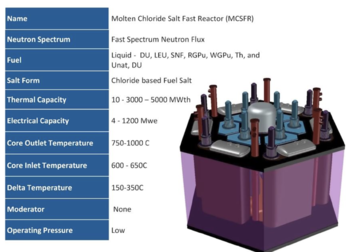FC-MSR nuclear reactor
- See also: Nuclear_power_reconsidered
The FC-MSR is a Molten Salt Reactor[1] using Fast neutrons and a Chloride salt. Fast Neutron Reactors[2][3] are capable of burning spent nuclear fuel, old bomb cores, depleted uranium and thorium.[4]
This article is a brief summary of information provided by Elysium Industries addressing the issues raised in the parent article Nuclear power reconsidered. For more details see the company website[5] and their booklet prepared for the IAEA.[6]
Safety
Accidental overheating. Fission stops quickly if the continuous flow of fuel out the bottom of the reactor is not replenished by pumping to the top. Decay heat is absorbed by a massive pool of molten salt around the reactor vessel. Shutdown is quicker and even more reliable than a freeze plug. Pumping will stop if there is a loss of power, overheating, a turbine trip, operator command, or a shutdown signal from any of various sensors in and around the reactor. No operator action is required, and there is nothing an operator can do to stop a safe shutdown. There are no electronic or electrical safety-critical systems or valves, and no vulnerability to cyber attack. The reactor is "walk-away safe".
Leakage of Radioactivity The molten salt fuel is at much lower pressure than a standard Pressurized Water Reactor, and there is no water near the molten salt.
Sabotage The reactor will be in a silo underground, so no vulnerability to airplanes or tornadoes.
Waste Management
<<This section is copied from ThorCon nuclear reactor. We need equivalent data for the FC-MSR.>>
All reactor maintenance and fuel processing is done at a secure location.
Average per year for a 500MW plant:[7]
High Level Waste: 13,400kg to dry-cask storage[8]
Medium and Low Level Waste: 343 tonnes of irradiated steel (one of the 4 "cans") shipped out for refurbishment.
Recycled Fuel: 650kg of 19.7% U-235 (33% of total U consumption)
Other: (Medical isotopes, etc.)
The "waste" in the ThorCon fuel cycle is actually valuable fuel for future fast neutron reactors capable of efficiently burning thorium and depleted uranium. This will extend proven resources from centuries to millennia.
Weapons Proliferation
Normal reprocessing of spent nuclear fuel from standard water moderated reactors involves separation of fissile material from the waste, and could lead to weapons-grade plutonium. This separation step is not necessary, however, if the spent fuel is to be used in a fast neutron reactor. These reactors can tolerate a much higher level of contaminants in the reprocessed fuel.
Elysium's process for making fresh fuel from spent fuel rods is very simple. The rods are chopped into 2cm chunks and dissolved in a vat of molten chloride salt. The solids are filtered out and the remaining liquid is used as fuel. Plutonium is added to bring the total fissile to the 10% needed for sustained burning. Weapons-grade plutonium, left over from the cold war, is denatured (diluted with reactor-grade plutonium) as it is added to the molten salt. At no point in the further processing or consumption of fuel is there any weapons-grade material.[9]
Cost
<<This section is copied from ThorCon nuclear reactor. We need equivalent data for the FC-MSR.>>
The expected cost of a complete power plant will be less than a coal plant of equal power.[10] Everything in the fission island except the structure itself is replaceable. Every four years the sealed reactor and entire primary loop
is changed out, returned to a centralized recycling facility, decontaminated, disassembled,
inspected, and refurbished. Incipient problems are caught before they can turn into casualties.
Thorcon plants with replaceable sealed reactors can operate for 80 years; but, if a ThorCon is decommissioned, the
process is little more than pulling out but not replacing all the replaceable parts.[11]
Specs for a 500MW plant:[12]
Plant cost per KW: $1200
Operating cost per KWh: $0.03 (including $0.006 for fuel)
Fuel consumption per day: 5.3kg of 19.7% enriched uranium plus 9.0kg of thorium.[13]
-145 tonnes of natural uranium per GW-year compared to about 250 tonnes for a standard light water reactor
- future re-enrichment of spent fuel will cut this uranium requirement by a third
Initual fuel load (2 cans): 78,000kg NaF-BeF2-ThF4-UF4 (76-12-10.2-1.8 mol %)
Notes and References
- ↑ Molten Salt Reactors World Nuclear Association Information Library.
- ↑ Fast Neutron Reactors World Nuclear Association Information Library.
- ↑ Fast neutron reactors Wikipedia
- ↑ TEAC presentation Ed Pheil, the designer, speaks at Thorium Energy Alliance 2019.
- ↑ Elysium Industries website
- ↑ International Atomic Energy Agency IAEA Booklet - Molten Chloride Salt Fast Reactor, Elysium Industries
- ↑ https://thorconpower.com/fuel/
- ↑ ThorCon power plants can store up to 80 years of used fuel onboard, using passive air cooling. https://thorconpower.com/fuel
- ↑ This video clip from Ed Pheil's presentation at TEAC 10 is the clearest explanation of Elysium's process.
- ↑ https://thorconpower.com/economics
- ↑ "ThorCon is Fixable" p.1 in ThorConIsle
- ↑ https://thorconpower.com/wp-content/uploads/2019/03/ThorConSpecSheet7.pdf
- ↑ https://thorconpower.com/fuel/
